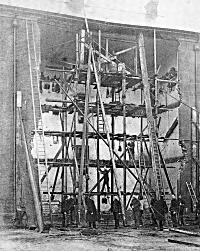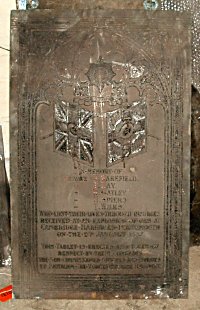
On Sunday 2nd January 1887, the 2nd Battalion of the Worcestershire Regiment were enjoying some respite from the bitter cold in Cambridge Barracks when at nine o'clock in the evening there was a tremendous explosion which blew out the walls from three stories of the solidly built barrack block. The cause of the disaster was later attributed to an explosion of gas, of which it was reported, a smell had previously been detected.

The three rooms affected by the blast were occupied by "F", "G" and "C" Companies, but it wasn't known how many men were present as some were away on pass. Initially, the explosion was not very generally known outside the barracks as those in the town who had heard it assumed it was the firing of the evening gun. Inside it was painfully apparent. The report was followed by a concussion which broke the windows of almost every quarter of the barracks, and stones, bricks and woodwork were hurled with great violence across the parade ground as the entire front of the three tiers of barrack-room in question had been blown out bodily into the square.
Lanterns and ships' lights were sent for as other regiments in the garrison hastened to render assistance. As well as the front wall blowing out the upper two floors had fallen and buried occupants beneath the debris. Ambulances were summoned but with the intense cold the roads were frozen and the horses could not gain a footing. The only alternative was for the men to pull the ambulances themselves, to and from the Station Hospital on Lion Terrace.
Work to free the trapped men continued until 3 o'clock in the morning when a halt was declared until daylight though many complained that they should have continued. In the morning it was discovered that Privates Wakefield, Gateley, Kay, and Spiers had perished and that a further 15 soldiers were injured, Private Wilks subsequently dying from his injuries.
Examination of the ruined building showed that the cause of the disaster was indeed an explosion of gas, which must, it is thought, have collected very low down in the basement, as the force of the explosion was upwards in the lower room.

At Osborne House on the Isle of Wight Queen Victoria was told of the disaster and immediately despatched Colonel Byng to assess the damage, visit the injured and report back to the Queen. On the Wednesday morning the Worcestershire Regiment were assembled on the Parade Ground to hear a message of condolence from her majesty. The following day a full military funeral procession set out for Highland Road Cemetery where the men were buried in a single grave.
A memorial to the five victims of the blast was erected at the Royal Garrison Church by the officers and men of the 2nd Battalion, the Worcestershire Regiment, but ironically this too suffered from an explosion when the church was bombed during World War II. Along with many other such memorials the Worcestershire memorial was placed in store at Fort Brockhurst in Gosport. From there it was rescued by Portsmouth Grammar School, which had taken over the barracks in 1927, when they asked permission of English Heritage to restore the plaque and display it at the site of the explosion.
The damaged building was swiftly repaired and re-occupied, though evidence of the re-built section of wall was plain for all men on the Parade Ground to see. Although that section has now experienced 120 years of weathering it is still possible to determine the extent of the explosive effects.
Tim Backhouse
January 2008
REFERENCES
Hampshire Telegraph, 8th January 1887
"A History of Cambridge Barracks" by Catherine Smith
The website "Memorials and Monuments in Portsmouth"
WITH THANKS TO:-
English Heritage
The Worcestershire Regimental Museum
The Friends of the Royal Garrison Church